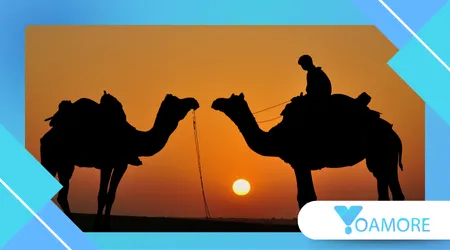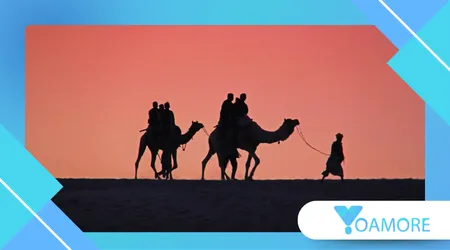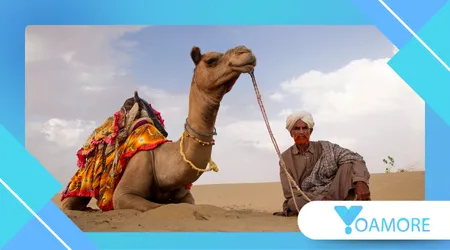The Camel Whisperers of Rajasthan: A Look at Their Secret Signals

The camel whisperers of Rajasthan embody a profound, centuries-old relationship between humans and animals, a bond built on trust and a secret language.
Anúncios
This fascinating article explores the unique communication methods used by these communities, delving into the deep cultural and economic importance of camels in their lives.
We will uncover the unspoken signals, the cultural traditions, and the modern challenges facing these remarkable people. Join us as we journey into a world where a quiet whistle can mean everything.
The Legacy of the Raika Community
A Nomadic Heritage
The Raika people, a pastoral community in Rajasthan, are the renowned keepers of these incredible animals.
Their identity and livelihood are inextricably linked to the camels they herd across the arid landscapes.
Anúncios
For generations, they have perfected an intricate art of communication, a heritage passed down from father to son. It is a legacy that defines their way of life.
This profound bond isn’t merely about herding; it’s a form of symbiotic living, where the well-being of one depends entirely on the other.
+ Why Streetwear Became a Cultural Statement
The Camel’s Importance
Camels are far more than just beasts of burden for the Raika. They provide milk, wool, and transportation across the vast Thar Desert.
Their economic stability and social status are directly tied to the health and size of their camel herds. A camel is a living, breathing asset.
The Raika’s deep understanding of their camels’ behavior and needs is a critical survival skill. It is a knowledge system refined over centuries of cohabitation.
The Secret Language of the Desert

Whispers and Whistles
The term “camel whisperer” is no exaggeration. Raika herders don’t rely on loud commands or physical force. Instead, they use a subtle form of communication.
This includes soft whistles, specific clicks of the tongue, and a range of body gestures that camels understand perfectly. It is a form of silent command.
The camel, in turn, responds with its own set of gestures, ear movements, and vocalizations that the herder interprets. This is a two-way conversation.
+ Afro-Brazilian Candomblé: Ritual, Resistance, and Community
Reading the Camel’s Mind
A skilled Raika can tell a camel’s mood or health by its posture, the position of its hump, or the flick of its tail. This is a form of non-verbal dialogue.
For example, a low grunt might indicate contentment, while a tense posture signals unease. Every subtle movement carries a specific meaning.
The herders learn to anticipate their camels’ needs, moving them to a new grazing spot before the current one is depleted. This foresight is a result of their silent communication.
Modern Challenges and Cultural Preservation

A Changing World
As modern transportation and farming methods penetrate Rajasthan, the traditional lifestyle of the Raika is under threat.
Fewer young people are choosing to follow the nomadic path, drawn to the opportunities and stability of city life. This shift endangers their unique culture.
The ancient art of communicating with camels is slowly fading as the number of active camel whisperers of Rajasthan dwindles.
The Struggle for Survival
A significant challenge is the shrinking of grazing lands. Urbanization and agriculture are encroaching on the desert, limiting the space for their herds.
This makes it harder for the Raika to sustain their traditional nomadic lifestyle, putting pressure on their cultural identity and economic model.
According to a 2023 report from the Lokhit Pashu-Palak Sansthan (LPPS), a non-profit dedicated to animal keepers, the camel population in Rajasthan has been steadily declining.
The Economic and Social Fabric
Camel Milk and Its Value
Camel milk, a staple of the Raika diet, is now gaining attention for its health benefits. It is rich in vitamins and low in fat.
This has opened new avenues for income, with cooperatives being formed to commercialize camel milk products. It offers a lifeline for these communities.
This new market provides a modern economic incentive to continue the herding tradition, helping preserve the skills of the camel whisperers of Rajasthan.
+ Chhau Dancers of Eastern India: A Microculture of Myth and Movement
Camel Fairs and Festivals
The annual Pushkar Camel Fair is a vibrant cultural event and a crucial marketplace for the Raika. It is where they trade their best animals.
It’s also a celebration of their heritage, featuring races, music, and traditional performances. The fair brings together different communities.
The fair is a testament to the enduring cultural significance of camels and their keepers. It highlights their role in the region’s cultural landscape.
A Table of Camel Whisperer’s Signals
| Signal Type | Meaning | Context |
| Specific Whistle | Move forward or change direction | Guiding the herd across the desert. |
| Soft Tapping | Lie down and rest | Signalling it’s time to take a break. |
| Subtle Body Posture | A warning or threat is perceived | Alerting the camel to potential danger. |
| Singing or Humming | Reassurance and bonding | Calming the animal or a sign of affection. |
| Clicking Sound | Stop or stay in place | Keeping the camel from wandering off. |
A Glimpse into the Future
Balancing Tradition and Modernity
How can a community built on ancient traditions adapt to a rapidly modernizing world without losing its soul? This is the central question facing the Raika.
Some initiatives focus on modernizing their livelihoods while preserving their culture. For example, providing mobile veterinary services for their herds.
Others are encouraging ecotourism, where visitors can learn directly from the camel whisperers of Rajasthan, creating a new source of sustainable income.
The Power of Storytelling
The stories and knowledge of the Raika are invaluable. They are repositories of ecological wisdom and a unique cultural heritage.
Sharing these stories through documentaries and books helps raise global awareness of their plight and their extraordinary skills.
This storytelling ensures that the unique bond between the Raika and their camels isn’t lost to time. It’s a powerful tool for cultural preservation.
A Lesson in Symbiosis
The relationship between the Raika and their camels is a beautiful analogy for our own need to live in harmony with our environment.
Just as the herders understand their camels’ subtle needs, we too must learn to listen to the planet’s silent signals. It is a delicate balance.
The incredible history of the Raika people and their camels can be further explored at the Raika Camel Preservation Trust, an organization dedicated to supporting this unique community.
This deep connection is a testament to the power of mutual respect and understanding. It shows that communication doesn’t always require words.
The existence of the camel whisperers of Rajasthan reminds us of the profound connections that are possible between species.
These are not merely animals and their owners; they are partners in a shared existence, a bond of trust forged in the harsh beauty of the desert.
The skills of these herders, their silent language, and their nomadic way of life are precious cultural treasures that deserve to be protected.
The tradition of the camel whisperers of Rajasthan is a living, breathing piece of history.
Their knowledge is an invaluable resource for understanding animal behavior, cultural heritage, and sustainable living in extreme environments.
The deep bond between the Raika and their camels, a testament to mutual respect, is something we can all learn from.
For more information on micro-cultures and their efforts to preserve their way of life, you can visit Cultural Survival, a leading non-profit organization in this field.
